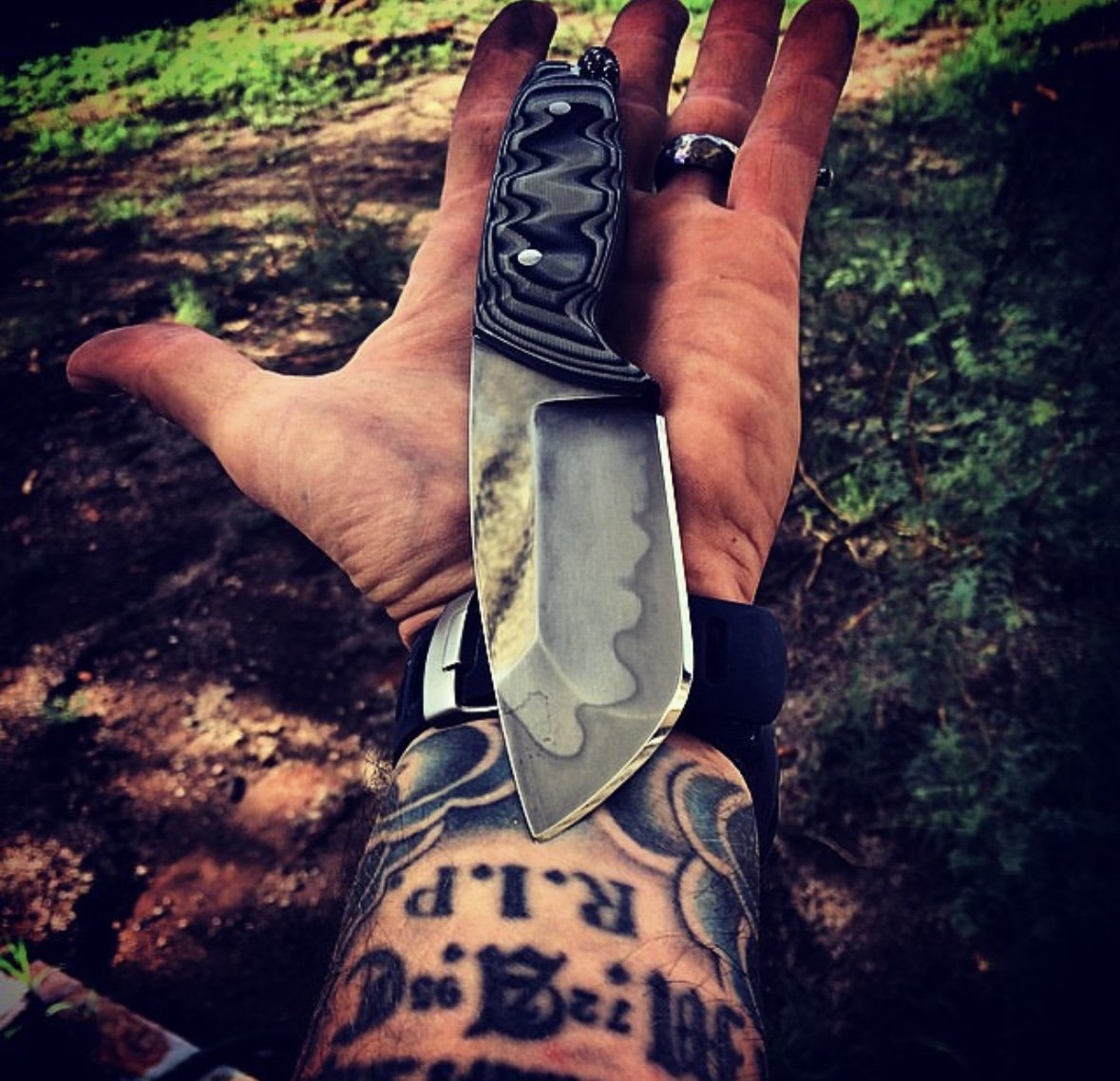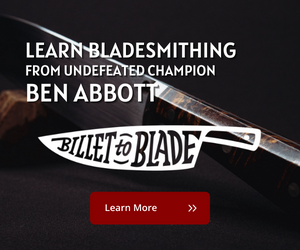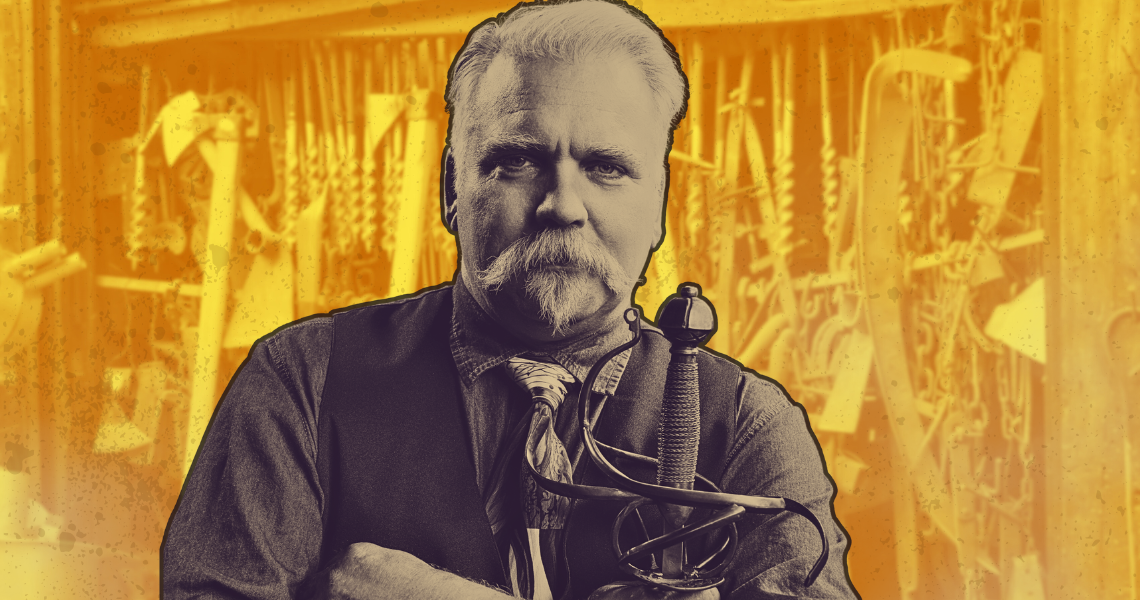Come Do Some Desert Metal Crafting with Bladesmith Rich Greenwood
Since its premiere in 2015, Forged in Fire has become a globally recognized show that has inspired many people to try forging and smithing. The show is now filming for its tenth season, with no plans to slow down. But many aspects of the show have changed since that first season. This week we are excited to bring you one of the show's first contestants, Rich Greenwood.
RELATED: AFTER THE ANVILS FIF EPISODE #1- WHERE ARE THEY NOW?
Rich first appeared in season one, episode one, and then returned for the “Fan Favorites” episode in season three. Since then, he has continued to pursue his passion. We caught up with Rich to talk about his appearances on the show, how it changed between seasons one and three, and what he’s been up to since it aired.
(Image credit: Rich Greenwood)
BRUTE de FORGE: How did you get into forging and bladesmithing?
RICH GREENWOOD: A buddy of mine had been doing it for about twenty-five years, and I had known him for almost fifteen years at that point. Anyway, he invited me to his house to help heat treat a sword. It was a Japanese short sword or wakizashi. But, through the process and watching him do that, I got hooked. It was the heat treat process that got me; the Japanese-style heat treat.
“I’ve never been disappointed in something I’ve done, as much as I’ve been disappointed in something I haven’t done.”
I just got hooked, and within three weeks of helping him with that heat treat, I had a basic forge setup. I started with small knives and straight razors, and it grew from there. That was about fifteen years ago, which is crazy. Times flies. I wish I had realized earlier that it was something that I would enjoy and something I was good at.
BDF: Are you a full-time bladesmith?
RG: No, I still work a day job. I worked in the swimming pool industry for twenty years but had to get out of the sun. Then at the beginning of this year, I went to work at a machine shop that my buddy, Kevin, owns. It’s called Potter USA. We manufacture jewelry-making equipment.
But the primary reason I don’t bladesmith full-time is that I don't want to get burned out on it. I'm afraid if I do it full-time, I'll get burned out, and it won’t be as fun anymore.
I have a school here in town, though, and we teach blacksmithing, bladesmithing, welding, and, honestly, a little bit of everything. We teach all kinds of metal arts.
BDF: Yes, I wanted to ask you about your school. It’s called Desert Metal Craft. How did that get started?
RG: Shortly after I was on Forged in Fire, I was asked to do a lecture at the college for a metallurgy class. I went in and did the lecture and ended up hanging out in the class for three or four weeks. The instructor’s final exam for the students was to have the kids make a knife out of a two-inch by three-inch piece of leaf spring. So, I went in and gave them a rough idea of how they would forge it out, and they took to it. I really enjoyed talking to them, so I stayed for, like, three weeks.
Then, when I was getting ready to leave, the instructor said, “Hey, you know, they are looking for a blacksmithing instructor at the other campus?” I said, “I never graduated high school; they won't let me teach at a college.” She said, “You'd be amazed. Go over there and talk to them. It's the art department.”
I went over and talked to them, and they offered me the job on the spot. I ended up teaching at Pima Community College for three years. I did six semesters and taught twelve classes with sixteen students each. I met a lot of kids. Unfortunately, the bureaucracy was a little heavy. Everybody talks about the bureaucracy in colleges and higher education. I had no idea what that really meant until I went there and taught for as long as I did. That part wasn't my cup of tea, but I really enjoyed the teaching aspect.
At the end of my time there, I approached Liz Cameron, the instructor I initially lectured for, and said, “Listen, I really enjoyed teaching. What do you think about opening a co-op or a school?” And she said, “That's a great idea. Let's do it!” So, within about three months, we had a space, and a month after that, we had another partner who has since moved on. He moved to Portugal at the beginning of COVID, but he was our marketing director at the university and helped us out initially. He did all of our marketing: contacting all the news stations, getting us interviews, getting us spots in the newspaper, and all kinds of marketing.
(Image credit: Rich Greenwood)
We have been up and running for six years, and I love it! The vast majority of our classes are in the evenings and on weekends. Occasionally, we bring in an outside instructor. We try and bring in people to come in and teach that are at the top of their craft. We've got Don Winn, a chef's knife maker who we are fortunate to have local, and he teaches some classes for us. We got Nick Rossi to come in and do some classes for us. Salem Straub is coming down. We're really excited! We put as much into it as we want to get out of it and feel like we're serving Tucson pretty well.
BDF: So, you said people could learn more than just bladesmithing. They can learn basically any metal art, correct?
RG: Yeah, we do welding, jewelry, and all kinds of classes. A lot of different techniques, blacksmithing—a little bit of everything! If it's got metal, we most likely have a class on it. Bladesmithing is by far our most popular class, though.
BDF: What is it that you enjoy about being a teacher?
RG: I enjoy learning from teaching. I’ve learned more from teaching than I have being taught by other people over the years. It teaches you a lot about yourself. Everybody's got a different way of doing things. Even a bare-bones beginner can show you some tricks. Working with somebody who's never done it before is really interesting. Don’t get me wrong, many of them don't know what they're doing, but once in a while, someone will pull something out of it and question something that you're doing that makes you question it. That's pretty cool.
BDF: Backing up a bit, what was it about the heat treatment process that initially got you hooked?
RG: There's so much that happens in such a short amount of time. You’re taking this piece of metal that's basically soft, for all intents and purposes, and through a process that can be between two and five minutes long, you're transforming that steel from one phase to another and making it usable. But then there are so many different ways to do it, and different types of steel react differently to different kinds of heat treatment. It's just such an interesting thing to me. There's so much that happens in such a short period of time.
“I enjoy learning from teaching. I’ve learned more from teaching than I have being taught by other people over the years.”
It’s really easy to screw up, but at the same time, if you do it right, it's a beautiful process. It could be the life of the blade, or it could be the death of the blade in a matter of seconds.
BDF: When crafting your blades, do you have a style that sets you apart from others?
RG: I do mostly a pseudo-Japanese style of knifemaking. I like the Japanese form, and all my knives are differentially heat treated. That's the style of treatment I like. It’s something that adds a lot to the knife. The vast majority of my blades are W2 steel and have a hamon, so my preferred heat treatment is to clay the blade with satanite, heat the blade in a forge rather than an oven, and quench in Parks 50 quenchant. After that, they get up to two hours of temper at four hundred degrees in the industrial heat treat oven.
BDF: What was it like to be on the first aired episode of Forged in Fire?
(Image credit: History)
RG: It was a blast! I had a lot of fun. I was asked to go on a show over Instagram. Somebody contacted me, and I thought it was odd, so I ignored it. They said, “Hey, we like the way your knives look, and we want you to be on this TV show that’s filmed in New York.” I laughed because I hadn't been making knives for very long, so there was no way they wanted me for TV.
Then about two weeks later, I was flipping through my messages, and I looked at my ex-wife, and I said, “You know, these people say that they want me to be on a TV show. Should I respond to this? I have no interest in being on TV.” She looked at me and said, “You don't want to be on TV?” I said, “Well, I'd really like to see how they film a television show.” She said, “Well, if you're interested, go for it.” So, I messaged them back, and within minutes, I had two phone calls from two different producers, and they were flying me out to New York!
It was crazy. It was neat, though. But, again, I had no aspirations to be on television, and I figured I'd get kicked off in the first round after they explained it all. I just thought I'd get a free trip to New York to see how it’s filmed, but I made it into the finals! It was just crazy.
BDF: Since you were one of the first contestants, you never got to see previous episodes, and you were basically flying blind. Did they give you any inkling as to what to expect?
RG: I would say that for the first season, we all went in blind. There were only eight episodes in the first season, and there were a lot of people that refused to go on the show because they didn't have anything to go by. There were many people that thought the show was fake. The contract they sent out with that first season was like an eighteen-page contract. It was actually the same contract they sent out for other reality shows, and one of the items in it said they could defame you, and there was nothing you could do about it. A lot of the bladesmiths that read the contracts said, “Oh hell no. That's crazy.” I just figured they couldn’t make me say anything I didn’t want to say.
(Image credit: Rich Greenwood)
But we had no idea. They hadn't even sold the show. Left Field Entertainment owned the show at that point and had the same producer as Chopped. They gave us an idea of what the format was going to be, but we didn't really know anything until we walked on set. One of the guys on the show, Matt Parkinson, had actually filmed the pilot, which was filmed six months prior in Washington. So, when I got there and started talking to Matt, he gave us an idea of what would happen and how it would work.
BDF: I am curious if you noticed many changes between your first and second episodes.
RG: There was a huge difference. Our filming days on that first episode were long. We started to film at six-thirty or seven in the morning, and we didn't leave the studio until around three or four. When I returned the second time, we went in at around seven in the morning and were out by six or seven o'clock at night. As I understand it now, they're starting at nine or ten in the morning and out by five in the evening. So, they’ve figured it out.
When they filmed at my home shop for the first time, they had at least one camera running for the entire fifty hours. I just watched them film an episode recently, and they turned a camera on a couple of times during the day, got two or three minutes of video in each shot, and moved on. It is totally different. They've cut their post-production time to a fraction of what it used to be.
BDF: In your first appearance, they gave you a bar of steel to use. Were you worried about what they would give you the second time? By then, they had started making the challenges a little more complicated for people.
RG: Yeah, by the time I did my second episode, I was like, “Oh, this is going to be a nightmare.” But it was still easy because they gave us a truck. You can't get any easier than that. But doing that ended up being a lot of drama for the studio because we disassembled that truck to the point where they couldn't get it out of the shop. It was definitely interesting. They could not get it out. They expected to be able to drag it out of the studio, and they couldn't do it.
BDF: Do you have any advice for people hoping to compete on the show one day?
RG: The advice I tell people, if they're going to go on the show, is that all you have to do is meet the parameters and not screw up your heat treatment. If you do those two things, you'll get into the finals. It's inevitable if you watch the show that two guys are going to screw something up, and that's all it takes: two guys screw things up, and you're in the finals. It's pretty simple.
“All you have to do is meet the parameters and not screw up your heat treatment.”
BDF: That’s the first time I’ve heard that advice about the show.
(Image credit: Rich Greenwood)
RG: It really is what I tell people. I’ve told students that, and a few went on and came in second place. It’s pretty simple; take your time, nail the heat treat, and meet the parameters. Done. I don't guarantee you'll win, but I will guarantee you make it into the finals.
BDF: Do you have any advice for aspiring bladesmiths or artists?
RG: I'd say I've never been disappointed in something I've done, as much as I've been disappointed in something I haven’t done. So, if you have an opportunity, take it and do it. You can always learn from it.
To see more of Rich Greenwood, follow him on Instagram @pokabu_forge. To learn more about Desert Metal Craft, visit their website at https://www.desertmetalcraft.org or follow them on Instagram @desertmetalcraft.
About The Author
More Interviews
























